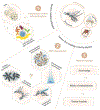Exploiting insect-specific viruses as a novel strategy to control vector-borne disease
- PMID: 32278312
- PMCID: PMC7302987
- DOI: 10.1016/j.cois.2020.02.005
Exploiting insect-specific viruses as a novel strategy to control vector-borne disease
Abstract
Novel insect-specific viruses (ISVs) are being discovered in many important vectors due to advances in sequencing technology and a growing awareness of the virome. Several in vitro and in vivo studies indicate that ISVs are capable of modulating pathogenic arboviruses. In addition, there is growing evidence that both vertical and horizonal transmission strategies maintain ISVs in vector populations. As such there is potential to exploit ISVs for stand-alone vector control strategies and deploying them in synergy with other symbiont control approaches such as Wolbachia-mediated control. However, before the applied potential can be realized, a greater understanding of their basic biology is required, including their species range, ability to be maintained and transmitted in native and non-native vector hosts, and the effect of infection on a range of pathogens.
Copyright © 2020 Elsevier Inc. All rights reserved.
Conflict of interest statement
Conflict of interest
The authors declare no conflict of interest.
Figures


Similar articles
-
Aedes Anphevirus: an Insect-Specific Virus Distributed Worldwide in Aedes aegypti Mosquitoes That Has Complex Interplays with Wolbachia and Dengue Virus Infection in Cells.J Virol. 2018 Aug 16;92(17):e00224-18. doi: 10.1128/JVI.00224-18. Print 2018 Sep 1. J Virol. 2018. PMID: 29950416 Free PMC article.
-
The virome of vector mosquitoes.Curr Opin Virol. 2021 Aug;49:7-12. doi: 10.1016/j.coviro.2021.04.002. Epub 2021 May 12. Curr Opin Virol. 2021. PMID: 33991759 Review.
-
Cell-Fusing Agent Virus Reduces Arbovirus Dissemination in Aedes aegypti Mosquitoes In Vivo.J Virol. 2019 Aug 28;93(18):e00705-19. doi: 10.1128/JVI.00705-19. Print 2019 Sep 15. J Virol. 2019. PMID: 31243123 Free PMC article.
-
Insect-Specific Viruses: An overview and their relationship to arboviruses of concern to humans and animals.Virology. 2021 May;557:34-43. doi: 10.1016/j.virol.2021.01.007. Epub 2021 Feb 9. Virology. 2021. PMID: 33631523 Review.
-
Unleashing Nature's Allies: Comparing the Vertical Transmission Dynamics of Insect-Specific and Vertebrate-Infecting Flaviviruses in Mosquitoes.Viruses. 2024 Sep 23;16(9):1499. doi: 10.3390/v16091499. Viruses. 2024. PMID: 39339975 Free PMC article. Review.
Cited by
-
Diversity and infectivity of the RNA virome among different cryptic species of an agriculturally important insect vector: whitefly Bemisia tabaci.NPJ Biofilms Microbiomes. 2021 May 13;7(1):43. doi: 10.1038/s41522-021-00216-5. NPJ Biofilms Microbiomes. 2021. PMID: 33986295 Free PMC article.
-
An RNA Virome Analysis of the Pink-Winged Grasshopper Atractomorpha sinensis.Insects. 2022 Dec 22;14(1):9. doi: 10.3390/insects14010009. Insects. 2022. PMID: 36661938 Free PMC article.
-
The diversity of viral community in Sogatella furcifera revealed by meta-transcriptomics.Front Microbiol. 2025 Jun 18;16:1617239. doi: 10.3389/fmicb.2025.1617239. eCollection 2025. Front Microbiol. 2025. PMID: 40606175 Free PMC article.
-
Genomic characterization of Volzhskoe tick virus (Bunyaviricetes) from a Hyalomma marginatum tick, Hungary.Sci Rep. 2024 Aug 15;14(1):18945. doi: 10.1038/s41598-024-69776-8. Sci Rep. 2024. PMID: 39147851 Free PMC article.
-
Metagenomic analysis of mosquitoes from Kangerlussuaq, Greenland reveals a unique virome.Sci Rep. 2025 May 17;15(1):17141. doi: 10.1038/s41598-025-01086-z. Sci Rep. 2025. PMID: 40382365 Free PMC article.
References
-
- Calisher CH, Higgs S: The discovery of arthropod-specific viruses in hematophagous arthropods: An open door to understanding the mechanisms of arbovirus and arthropod evolution? Annu Rev Entomol 2018, 63:87–103. - PubMed
-
*This review provides a comprehensive list of known ISVs, including a history of their discovery.
-
- Romo H, Kenney JL, Blitvich BJ, Brault AC: Restriction of Zika virus infection and transmission in Aedes aegypti mediated by an insect-specific flavivirus. Emerg Microbes Infec 2018, 7:181. - PMC - PubMed
-
**This study used NHUV to reduce titer and transmission of flaviviruses in Aedes cells and mosquitoes. These experiments demonstrated that NHUV could interfere with pathogenic virus infections in multiple hosts, building on previous results from WNV in Culex mosquitoes.
Publication types
MeSH terms
Substances
Grants and funding
LinkOut - more resources
Full Text Sources
Research Materials

